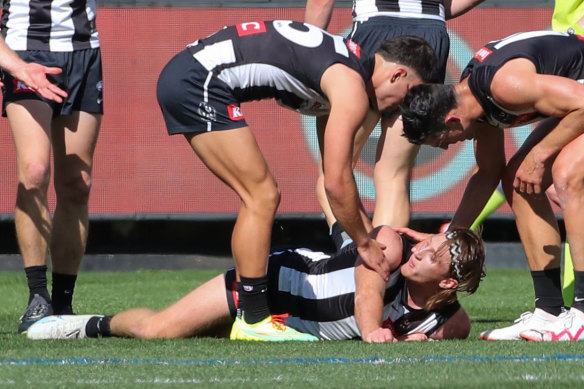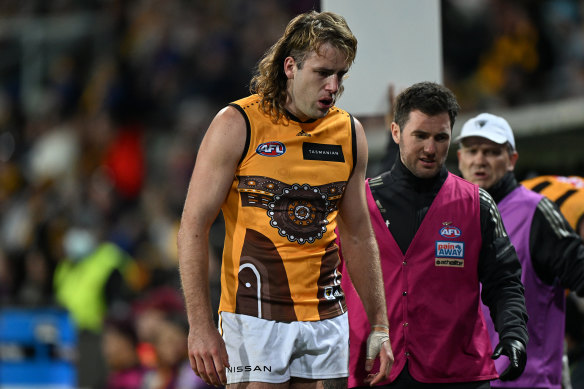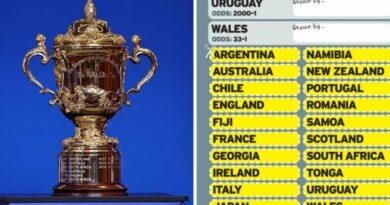Retired Hawk, brain experts say concussion tests open to manipulation
Save articles for later
Add articles to your saved list and come back to them any time.
Two leading neurologists and a former player who retired because of concussion believe some aspects of the AFL’s match-day tests for assessing potential brain injuries should be improved to prevent manipulation by players.
Amid hopes for a blood test that could provide more accurate diagnoses, experts say visible symptoms should more often rule players out of a game because the recall tests used to assess concussion could be memorised.
Teammates check on Nathan Murphy before he was subbed off.Credit: Paul Rovere
Their comments follow Collingwood premiership defender Nathan Murphy’s grand final day concussion, after which he told this masthead he ruled himself out because he was experiencing blurred vision and had previously sustained delayed concussions.
Murphy said he knew the testing process “off by heart”, which enabled him to pass the assessment more easily.
The 23-year-old’s game effectively ended after he head crashed into Brisbane Lions forward Lincoln McCarthy’s left shoulder late in the opening quarter of the Magpies’ four-point triumph.
The experts, La Trobe University Professor Alan Pearce and Macquarie University neurologist Rowena Mobbs, said they hoped Murphy’s decision could be a turning point in concussion education.
Club doctors use video to assess incidents and run through a symptom list during a concussion assessment, asking players to describe which of them they are experiencing and how severe they are. This protocol was developed by the AFL and implemented by clubs.
Pearce said there would then be a series of in-the-moment questions, such as which team they are playing and which quarter it is, before immediate memory testing, which includes five or 10 words, but this was open to manipulation because the words are drawn from only three lists.
“We’re still using the same sort of procedure or protocol as we have for the last 30 years. We haven’t really progressed at all, I don’t think, in this space,” Pearce said.
Mobbs said any sign of concussion, such as ataxia (loss of co-ordination), confusion, limb posturing (involuntary flexing of arms or legs) or loss of consciousness, “means it’s time for that player to go [out of a match] rather than face a question of return during a HIA [head injury assessment] process”.
“Fans at home might well see these signs, and commentators are getting better at calling them out,” Mobbs said.
“Training of commentators on concussion signs would be a great step. Even competitively speaking, a concussed player is unlikely to be a contributor to the team and should exit immediately with the coach’s encouragement.”
Mobbs would also like the mandated recovery period to increase from a minimum of 12 days to closer to four weeks.
Pearce, who is also a research manager at the Australian Sports Brain Bank, lauded Murphy’s decision to prioritise his brain health.
“This is all in the heat of the moment, too, which makes it even more remarkable,” Pearce said.
“He’s obviously realised that he won’t play at his optimum if he’s got blurry vision, or a few subtle symptoms that [may not have been] picked up by the doctor … I think he’s tougher in ruling himself out than trying to be tough and courageous playing on. This is an incredible moment in understanding concussion as a brain injury.”
Pearce wants the AFL to start collating data from rapid biomarker measures, including blood or saliva testing, to help with doctors’ assessments, even while accepting it is still not at a level for immediate results.
Former Hawthorn and Collingwood ruckman Max Lynch, who retired in August, less than three months after his 11th concussion, including nine in the AFL, would like to see the system changed.
“It’s all digital, so surely they can generate more than three lists,” Lynch said. “For every concussion, you do the [Sport Concussion Assessment Tool] four or five times before going back to play, so over a long period of time, you can probably remember them, especially the closer you get to play.”
Max Lynch has retired from football to avoid any risk of future damage due to concussion.Credit: Getty Images
Mobbs said it was possible to memorise or practise “some aspects” of testing in advance.
A reverse digit scan is also involved, where the doctor will state a group of numbers – from three to six digits – that the player needs to repeat in opposite order, then a similar test on the months of the year.
The AFL declined to comment on whether the tests were fit for purpose. Collingwood did not elaborate on Murphy’s testing during the grand final.
The AFL Players Association’s Insights and Impacts Report, based on a survey of male and female players and released in June, revealed 9 per cent of respondents admitted to not reporting a concussion in 2022, an increase on the five-year average of 7 per cent.
Lawyer and ex-Western Bulldogs president Peter Gordon told club bosses at an AFL meeting last week that the league had a responsibility to keep players educated about the associated risks.
Two people in the meeting, who were not authorised to speak publicly, confirmed the discussion was part of a wide-ranging presentation on concussion made to club CEOs and presidents ahead of the Brownlow Medal count.
Lynch, 25, has regained his memory after an extended period when he would regularly forget basic things, but admits to concern about his long-term future.
He is studying at university and working as a development coach with Hawthorn’s AFLW team.
“I wanted to forget I had all those concussions and just live a normal life, but when I saw ‘Murph’ get hit, it brought back some bad memories – and that happens every time I see someone concussed,” Lynch said.
“Hearing from all the experts and them saying, ‘I think you’re all right, but we don’t have enough data to know’ was the scary part. It’s unfortunate, but we need more people to get concussed, to then know how to deal with it. I wish I had that [evidence] to say how I’m going to be when I’m older.
“That was a massive part of my decision [to retire], after speaking to my family. I’m a big family man, and I want to be all right when I’m 50 or 60 to play with my kids.”
Lynch said the manner in which the Hawks and, in particular, head doctor Liam West handled his situation was “first class”, but he still felt the process could be improved.
There is no blood test approved globally for assessing concussion, but a collaborative study between Monash University and The Alfred emergency department discovered specific proteins – or biomarkers – that can help diagnose concussions in patients younger than 50 who presented to hospital within six hours of injury.
Monash trauma group principal investigator Stuart McDonald, who led the study, said making an accurate concussion diagnosis was often difficult as clinicians relied on symptoms, often self-reported, or tools such as imaging that lacked sensitivity to this form of brain injury.
“Consequently, even in the ED, individuals can be discharged without a definitive diagnosis,” McDonald said.
The league has a concussion spotter in its AFL Review Centre – the ARC – who ensures club doctors do not miss on-field incidents that occur, so they can check players who may be concussed, but there is also a responsibility on each club to ensure concussion protocols are applied with rigour.
Port Adelaide received a $100,000 fine this year after sending Aliir Aliir back on the ground following a heavy knock, without giving him a SCAT. The AFL fined the club but backed club doctors when handing down the sanction in August.
Gordon also touched on the potential exposure of club directors to concussion claims in the future. Club directors have been concerned about the level of indemnity insurance they have to cover concussion claims if they were directed at them personally.
For daily updates on all the AFL trade period action, sign up for our Real Footy newsletter.
Most Viewed in Sport
From our partners
Source: Read Full Article





